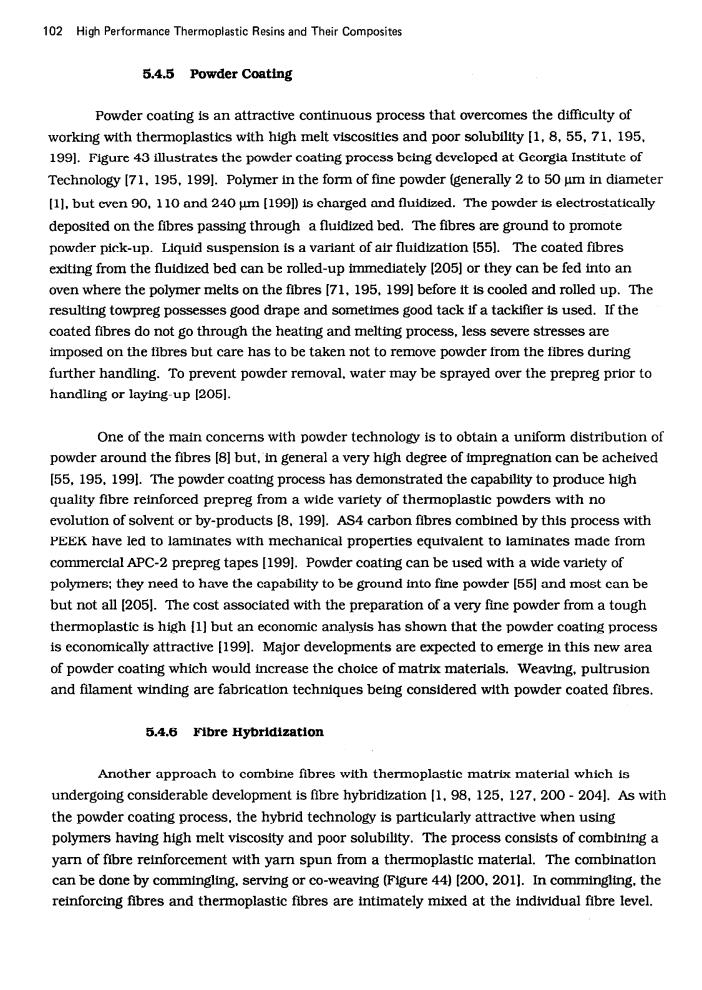正在加载图片...

102 High Performance Thermoplastic Resins and Their Composites 5.4.5 Powder Coating Powder coating is an attractive continuous process that overcomes the difficulty of working with thermoplastics with high melt viscosities and poor solubility [1,8,55,71.195. 1991.Figure 43 illustrates the powder coating process being developed at Georgia Institute of Technology [71.195,199).Polymer in the form of fine powder (generally 2 to 50 um in diameter [1],but cven 90,110 and 240 um [199])is charged and fluidized.The powder is electrostatically deposited on the fibres passing through a fluidized bed.The fibres are ground to promote powder pick-up.Liquid suspension is a variant of air fluidization (55].The coated fibres exdting from the fluidized bed can be rolled-up immediately [205]or they can be fed into an oven where the polymer melts on the fibres [71,195,199]before it is cooled and rolled up.The resulting towpreg possesses good drape and sometimes good tack if a tackifier is used.If the coated fibres do not go through the heating and melting process,less severe stresses are imposed on the fibres but care has to be taken not to remove powder from the fibres during further handling.To prevent powder removal.water may be sprayed over the prepreg prior to handling or laying-up [2051. One of the main concerns with powder technology is to obtain a uniform distribution of powder around the fibres [8]but,in general a very high degree of impregnation can be acheived 155.195.1991.The powder coating process has demonstrated the capability to produce high quality fibre reinforced prepreg from a wide variety of thermoplastic powders with no evolution of solvent or by-products [8.199).AS4 carbon fibres combined by this process with PEEK have led to laminates with mechanical properties equivalent to laminates made from commerclal APC-2 prepreg tapes [1991.Powder coating can be used with a wide variety of polymers:they need to have the capability to be ground into fine powder [55]and most can be but not all [205].The cost associated with the preparation of a very fine powder from a tough thermoplastic is high [1]but an economic analysis has shown that the powder coating process is economically attractive [199].Major developments are expected to emerge in this new area of powder coating which would increase the choice of matrix materials.Weaving,pultrusion and filament winding are fabrication techniques being considered with powder coated fibres. 5.4.6 Flbre Hybridization Another approach to combine fibres with thermoplastic matrix material which is undergoing considerable development is fibre hybridization [1,98,125.127,200-204].As with the powder coating process.the hybrid technology is particularly attractive when using polymers having high melt viscosity and poor solubility.The process consists of combining a yarn of fibre reinforcement with yarn spun from a thermoplastic material.The combination can be done by commingling.serving or co-weaving (Figure 44)[200.201].In commingling.the reinforcing fibres and thermoplastic fibres are intimately mixed at the individual fibre level.102 High Performance Thermoplastic Resins and Their Composites 5.4.5 Powder Coating Powder coating is an attractive continuous process that overcomes the diificulty of working with thermoplastics with high melt viscosities and poor solubility [ 1, 8, 55, 71, 195. 1991. Figure 43 illustrates the powder coating process being developed at Georgia Institute of Technology [71. 195. 1991. Polymer in the form of fine powder (generally 2 to 50 um in diameter [l], but even 90. 110 and 240 l.un [lQQ]) is charged and fluidized. The powder is electrostatically deposited on the fibres passing through a fluidized bed. The fibres are ground to promote powder pick-up. Liquid suspension is a variant of air fluidization 1551. The coated fibres exiting from the fluidized bed can be rolled-up immediately [205] or they can be fed into an oven where the polymer melts on the fibres 171, 195, 1991 before it is cooled and rolled up. The resulting towpreg possesses good drape and sometimes good tack if a tacklfier is used. If the coated fibres do not go through the heating and melting process, less severe stresses are imposed on the iibres but care has to be taken not to remove powder from the fibres during further handling. To prevent powder removal, water may be sprayed over the prepreg prior to handling or laying-up [205]. One of the main concerns with powder technology is to obtain a uniform distribution of powder around the fibres [8] but, in general a very high degree of impregnation can be acheived 155. 195. 1991. The powder coating process has demonstrated the capability to produce high quality ilbre reinforced prepreg from a wide variety of thermoplastic powders with no evolution of solvent or by-products (8. 1991. AS4 carbon fibres combined by this process with PEEK have led to laminates with mechanical properties equivalent to laminates made from commercial APC-2 prepreg tapes [ 1991. Powder coating can be used with a wide variety of polymers; they need to have the capability to be ground into fine powder [55] and most can be but not all [205]. The cost associated with the preparation of a very fine powder from a tough thermoplastic is high (11 but an economic analysis has shown that the powder coating process is economically attractive [ 1991. Major developments are expected to emerge in this new area of powder coating which would Increase the choice of matrix materials. Weaving, puhrusion and filament winding are fabrication techniques being considered with powder coated fibres. 5.4.6 Fibre Hybridization Another approach to combine fibres with thermoplastic matrix material which is undergoing considerable development is fibre hybridization [l. 98. 125, 127, 200 - 2041. As with the powder coating process, the hybrid technology is particularly attractive when using polymers having high melt viscosity and poor solubility. The process consists of combining a yam of fibre reinforcement with yam spun from a thermoplastic material. The combination can be done by commingling, serving or co-weaving (Figure 44) [200.201]. In commingling, the reinforcing Ilbres and thermoplastic fibres are intimately mixed at the individual fibre level